Auditing and Assurance: Financial Analysis and Audit of a Bank
VerifiedAdded on 2023/06/03
|22
|4990
|418
Report
AI Summary
This assignment solution provides a detailed analysis of auditing and assurance procedures within a banking context, specifically focusing on Sustainable Bank Limited (SBL). It covers key aspects such as audit planning, independent verification of financial reports, analytical procedures to assess liquidity and solvency, and evaluation of internal controls. The solution also addresses the impact of technological malfunctions, compliance with regulatory requirements like the Banking Act 1959 and Reserve Bank Act 1959, and the use of substantive audit procedures to identify potential misstatements. Furthermore, it explores the application of IT systems in auditing, including the use of spreadsheets and specialized software for data analysis and risk assessment. The document emphasizes the importance of maintaining minimum statutory balances with the Reserve Bank of Australia (RBA) and thoroughly investigating loan approval processes to mitigate risks associated with non-performing assets.
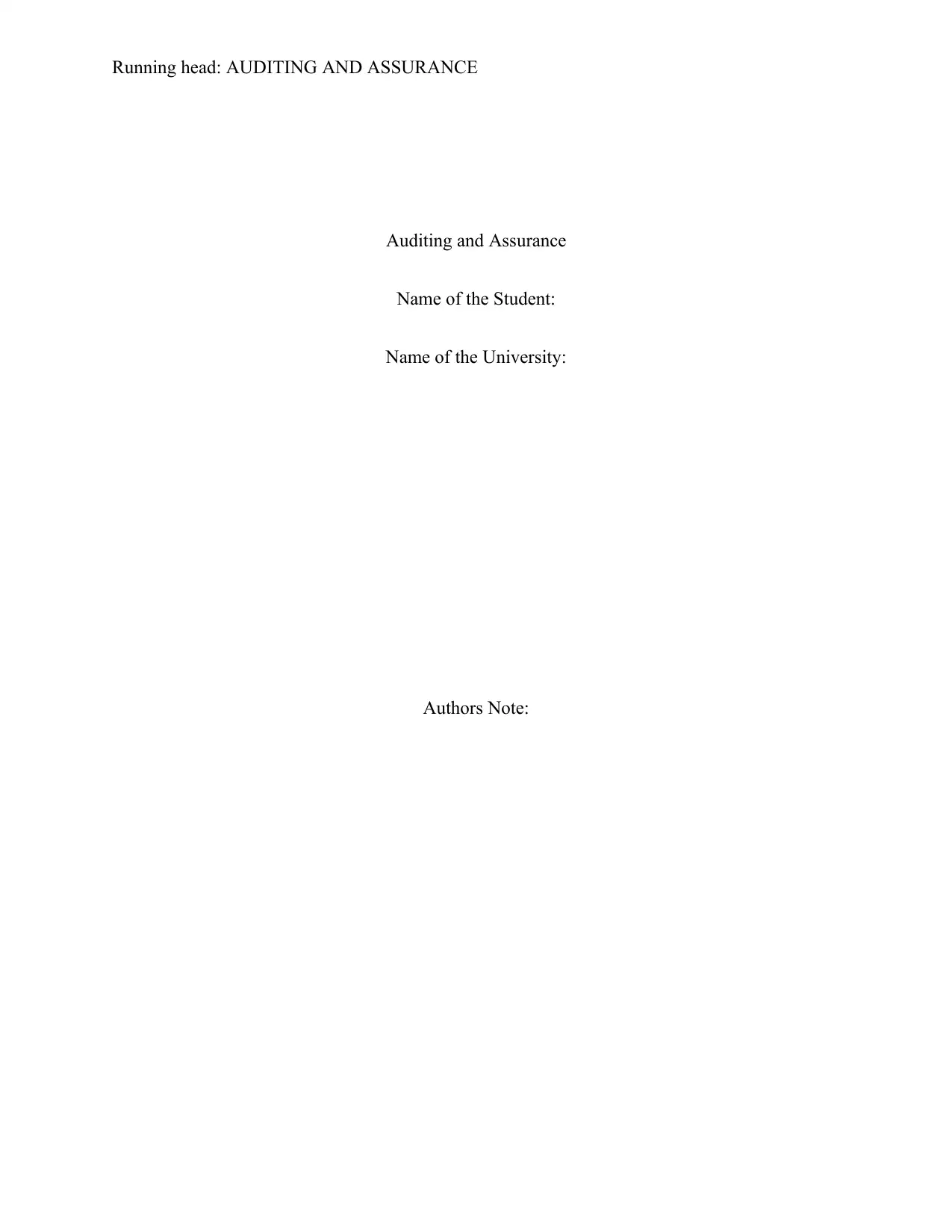
Running head: AUDITING AND ASSURANCE
Auditing and Assurance
Name of the Student:
Name of the University:
Authors Note:
Auditing and Assurance
Name of the Student:
Name of the University:
Authors Note:
Paraphrase This Document
Need a fresh take? Get an instant paraphrase of this document with our AI Paraphraser
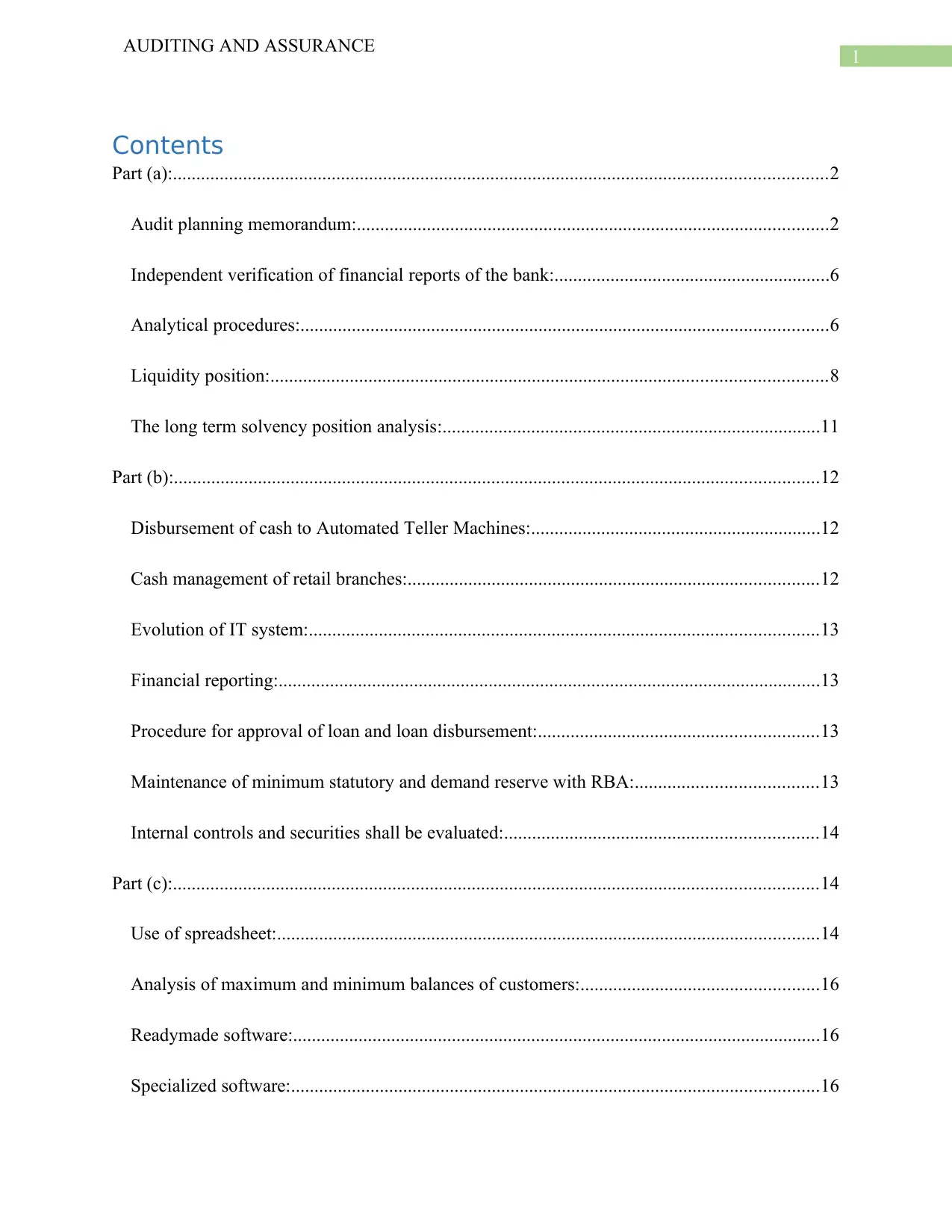
1
AUDITING AND ASSURANCE
Contents
Part (a):............................................................................................................................................2
Audit planning memorandum:.....................................................................................................2
Independent verification of financial reports of the bank:...........................................................6
Analytical procedures:.................................................................................................................6
Liquidity position:.......................................................................................................................8
The long term solvency position analysis:.................................................................................11
Part (b):..........................................................................................................................................12
Disbursement of cash to Automated Teller Machines:..............................................................12
Cash management of retail branches:........................................................................................12
Evolution of IT system:.............................................................................................................13
Financial reporting:....................................................................................................................13
Procedure for approval of loan and loan disbursement:............................................................13
Maintenance of minimum statutory and demand reserve with RBA:.......................................13
Internal controls and securities shall be evaluated:...................................................................14
Part (c):..........................................................................................................................................14
Use of spreadsheet:....................................................................................................................14
Analysis of maximum and minimum balances of customers:...................................................16
Readymade software:.................................................................................................................16
Specialized software:.................................................................................................................16
AUDITING AND ASSURANCE
Contents
Part (a):............................................................................................................................................2
Audit planning memorandum:.....................................................................................................2
Independent verification of financial reports of the bank:...........................................................6
Analytical procedures:.................................................................................................................6
Liquidity position:.......................................................................................................................8
The long term solvency position analysis:.................................................................................11
Part (b):..........................................................................................................................................12
Disbursement of cash to Automated Teller Machines:..............................................................12
Cash management of retail branches:........................................................................................12
Evolution of IT system:.............................................................................................................13
Financial reporting:....................................................................................................................13
Procedure for approval of loan and loan disbursement:............................................................13
Maintenance of minimum statutory and demand reserve with RBA:.......................................13
Internal controls and securities shall be evaluated:...................................................................14
Part (c):..........................................................................................................................................14
Use of spreadsheet:....................................................................................................................14
Analysis of maximum and minimum balances of customers:...................................................16
Readymade software:.................................................................................................................16
Specialized software:.................................................................................................................16
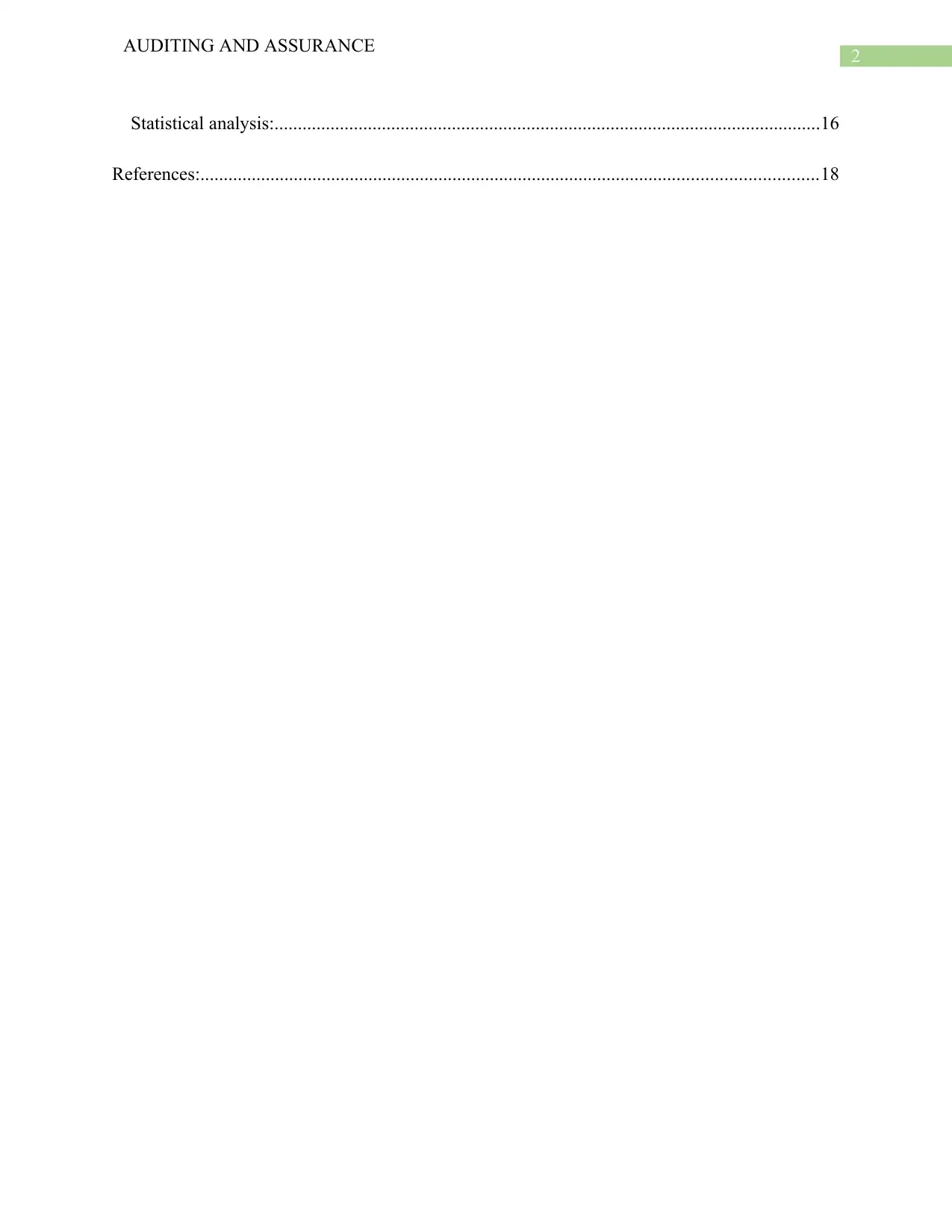
2
AUDITING AND ASSURANCE
Statistical analysis:.....................................................................................................................16
References:....................................................................................................................................18
AUDITING AND ASSURANCE
Statistical analysis:.....................................................................................................................16
References:....................................................................................................................................18
⊘ This is a preview!⊘
Do you want full access?
Subscribe today to unlock all pages.

Trusted by 1+ million students worldwide
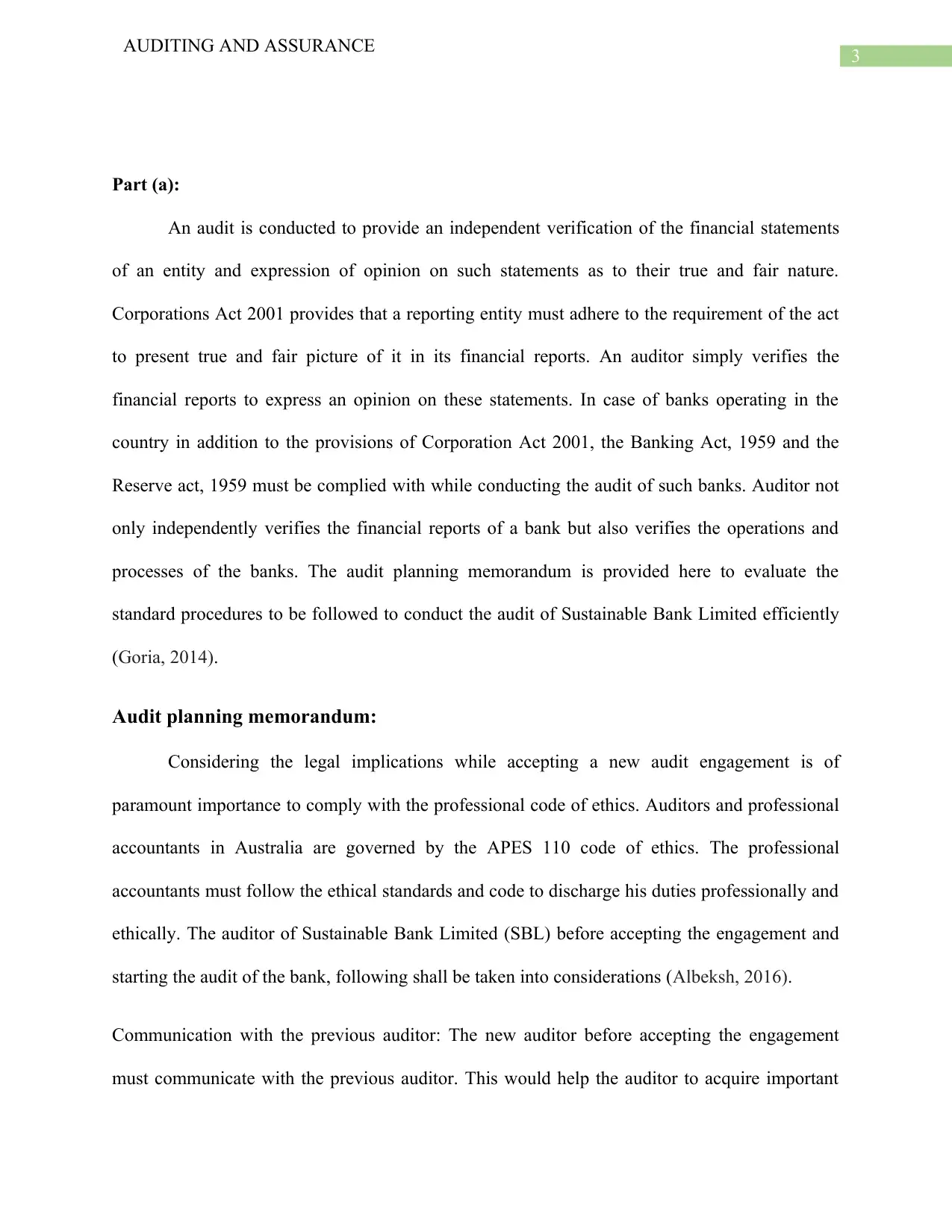
3
AUDITING AND ASSURANCE
Part (a):
An audit is conducted to provide an independent verification of the financial statements
of an entity and expression of opinion on such statements as to their true and fair nature.
Corporations Act 2001 provides that a reporting entity must adhere to the requirement of the act
to present true and fair picture of it in its financial reports. An auditor simply verifies the
financial reports to express an opinion on these statements. In case of banks operating in the
country in addition to the provisions of Corporation Act 2001, the Banking Act, 1959 and the
Reserve act, 1959 must be complied with while conducting the audit of such banks. Auditor not
only independently verifies the financial reports of a bank but also verifies the operations and
processes of the banks. The audit planning memorandum is provided here to evaluate the
standard procedures to be followed to conduct the audit of Sustainable Bank Limited efficiently
(Goria, 2014).
Audit planning memorandum:
Considering the legal implications while accepting a new audit engagement is of
paramount importance to comply with the professional code of ethics. Auditors and professional
accountants in Australia are governed by the APES 110 code of ethics. The professional
accountants must follow the ethical standards and code to discharge his duties professionally and
ethically. The auditor of Sustainable Bank Limited (SBL) before accepting the engagement and
starting the audit of the bank, following shall be taken into considerations (Albeksh, 2016).
Communication with the previous auditor: The new auditor before accepting the engagement
must communicate with the previous auditor. This would help the auditor to acquire important
AUDITING AND ASSURANCE
Part (a):
An audit is conducted to provide an independent verification of the financial statements
of an entity and expression of opinion on such statements as to their true and fair nature.
Corporations Act 2001 provides that a reporting entity must adhere to the requirement of the act
to present true and fair picture of it in its financial reports. An auditor simply verifies the
financial reports to express an opinion on these statements. In case of banks operating in the
country in addition to the provisions of Corporation Act 2001, the Banking Act, 1959 and the
Reserve act, 1959 must be complied with while conducting the audit of such banks. Auditor not
only independently verifies the financial reports of a bank but also verifies the operations and
processes of the banks. The audit planning memorandum is provided here to evaluate the
standard procedures to be followed to conduct the audit of Sustainable Bank Limited efficiently
(Goria, 2014).
Audit planning memorandum:
Considering the legal implications while accepting a new audit engagement is of
paramount importance to comply with the professional code of ethics. Auditors and professional
accountants in Australia are governed by the APES 110 code of ethics. The professional
accountants must follow the ethical standards and code to discharge his duties professionally and
ethically. The auditor of Sustainable Bank Limited (SBL) before accepting the engagement and
starting the audit of the bank, following shall be taken into considerations (Albeksh, 2016).
Communication with the previous auditor: The new auditor before accepting the engagement
must communicate with the previous auditor. This would help the auditor to acquire important
Paraphrase This Document
Need a fresh take? Get an instant paraphrase of this document with our AI Paraphraser
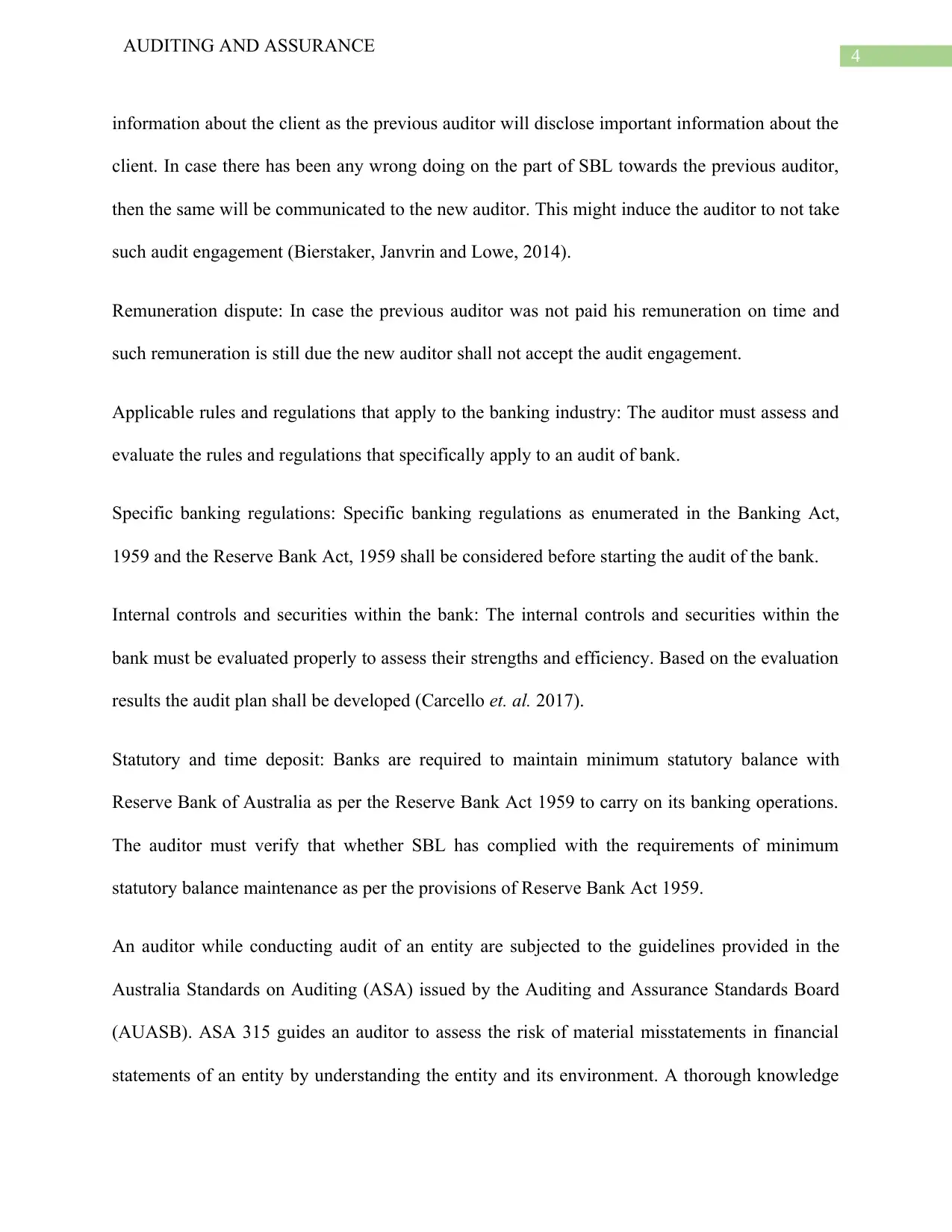
4
AUDITING AND ASSURANCE
information about the client as the previous auditor will disclose important information about the
client. In case there has been any wrong doing on the part of SBL towards the previous auditor,
then the same will be communicated to the new auditor. This might induce the auditor to not take
such audit engagement (Bierstaker, Janvrin and Lowe, 2014).
Remuneration dispute: In case the previous auditor was not paid his remuneration on time and
such remuneration is still due the new auditor shall not accept the audit engagement.
Applicable rules and regulations that apply to the banking industry: The auditor must assess and
evaluate the rules and regulations that specifically apply to an audit of bank.
Specific banking regulations: Specific banking regulations as enumerated in the Banking Act,
1959 and the Reserve Bank Act, 1959 shall be considered before starting the audit of the bank.
Internal controls and securities within the bank: The internal controls and securities within the
bank must be evaluated properly to assess their strengths and efficiency. Based on the evaluation
results the audit plan shall be developed (Carcello et. al. 2017).
Statutory and time deposit: Banks are required to maintain minimum statutory balance with
Reserve Bank of Australia as per the Reserve Bank Act 1959 to carry on its banking operations.
The auditor must verify that whether SBL has complied with the requirements of minimum
statutory balance maintenance as per the provisions of Reserve Bank Act 1959.
An auditor while conducting audit of an entity are subjected to the guidelines provided in the
Australia Standards on Auditing (ASA) issued by the Auditing and Assurance Standards Board
(AUASB). ASA 315 guides an auditor to assess the risk of material misstatements in financial
statements of an entity by understanding the entity and its environment. A thorough knowledge
AUDITING AND ASSURANCE
information about the client as the previous auditor will disclose important information about the
client. In case there has been any wrong doing on the part of SBL towards the previous auditor,
then the same will be communicated to the new auditor. This might induce the auditor to not take
such audit engagement (Bierstaker, Janvrin and Lowe, 2014).
Remuneration dispute: In case the previous auditor was not paid his remuneration on time and
such remuneration is still due the new auditor shall not accept the audit engagement.
Applicable rules and regulations that apply to the banking industry: The auditor must assess and
evaluate the rules and regulations that specifically apply to an audit of bank.
Specific banking regulations: Specific banking regulations as enumerated in the Banking Act,
1959 and the Reserve Bank Act, 1959 shall be considered before starting the audit of the bank.
Internal controls and securities within the bank: The internal controls and securities within the
bank must be evaluated properly to assess their strengths and efficiency. Based on the evaluation
results the audit plan shall be developed (Carcello et. al. 2017).
Statutory and time deposit: Banks are required to maintain minimum statutory balance with
Reserve Bank of Australia as per the Reserve Bank Act 1959 to carry on its banking operations.
The auditor must verify that whether SBL has complied with the requirements of minimum
statutory balance maintenance as per the provisions of Reserve Bank Act 1959.
An auditor while conducting audit of an entity are subjected to the guidelines provided in the
Australia Standards on Auditing (ASA) issued by the Auditing and Assurance Standards Board
(AUASB). ASA 315 guides an auditor to assess the risk of material misstatements in financial
statements of an entity by understanding the entity and its environment. A thorough knowledge
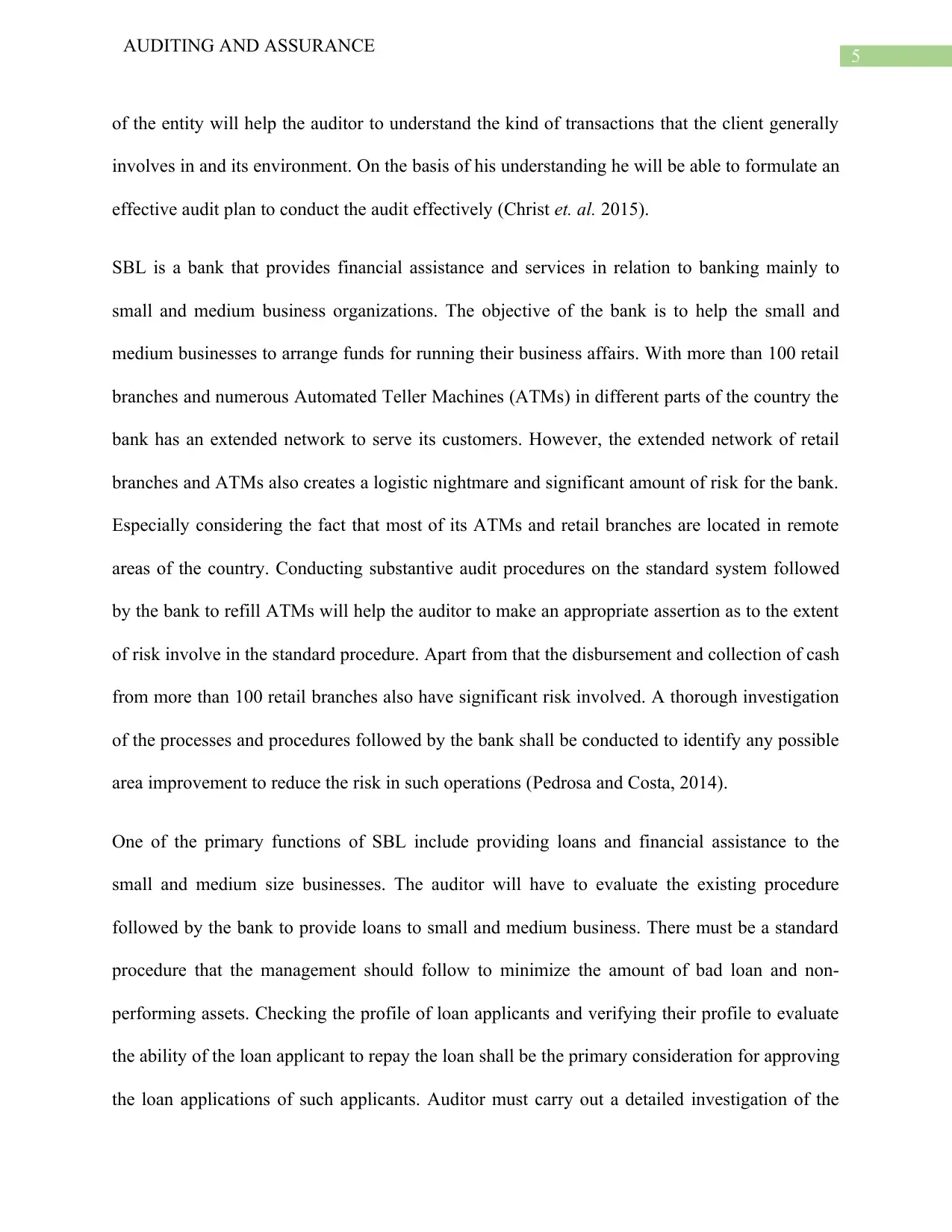
5
AUDITING AND ASSURANCE
of the entity will help the auditor to understand the kind of transactions that the client generally
involves in and its environment. On the basis of his understanding he will be able to formulate an
effective audit plan to conduct the audit effectively (Christ et. al. 2015).
SBL is a bank that provides financial assistance and services in relation to banking mainly to
small and medium business organizations. The objective of the bank is to help the small and
medium businesses to arrange funds for running their business affairs. With more than 100 retail
branches and numerous Automated Teller Machines (ATMs) in different parts of the country the
bank has an extended network to serve its customers. However, the extended network of retail
branches and ATMs also creates a logistic nightmare and significant amount of risk for the bank.
Especially considering the fact that most of its ATMs and retail branches are located in remote
areas of the country. Conducting substantive audit procedures on the standard system followed
by the bank to refill ATMs will help the auditor to make an appropriate assertion as to the extent
of risk involve in the standard procedure. Apart from that the disbursement and collection of cash
from more than 100 retail branches also have significant risk involved. A thorough investigation
of the processes and procedures followed by the bank shall be conducted to identify any possible
area improvement to reduce the risk in such operations (Pedrosa and Costa, 2014).
One of the primary functions of SBL include providing loans and financial assistance to the
small and medium size businesses. The auditor will have to evaluate the existing procedure
followed by the bank to provide loans to small and medium business. There must be a standard
procedure that the management should follow to minimize the amount of bad loan and non-
performing assets. Checking the profile of loan applicants and verifying their profile to evaluate
the ability of the loan applicant to repay the loan shall be the primary consideration for approving
the loan applications of such applicants. Auditor must carry out a detailed investigation of the
AUDITING AND ASSURANCE
of the entity will help the auditor to understand the kind of transactions that the client generally
involves in and its environment. On the basis of his understanding he will be able to formulate an
effective audit plan to conduct the audit effectively (Christ et. al. 2015).
SBL is a bank that provides financial assistance and services in relation to banking mainly to
small and medium business organizations. The objective of the bank is to help the small and
medium businesses to arrange funds for running their business affairs. With more than 100 retail
branches and numerous Automated Teller Machines (ATMs) in different parts of the country the
bank has an extended network to serve its customers. However, the extended network of retail
branches and ATMs also creates a logistic nightmare and significant amount of risk for the bank.
Especially considering the fact that most of its ATMs and retail branches are located in remote
areas of the country. Conducting substantive audit procedures on the standard system followed
by the bank to refill ATMs will help the auditor to make an appropriate assertion as to the extent
of risk involve in the standard procedure. Apart from that the disbursement and collection of cash
from more than 100 retail branches also have significant risk involved. A thorough investigation
of the processes and procedures followed by the bank shall be conducted to identify any possible
area improvement to reduce the risk in such operations (Pedrosa and Costa, 2014).
One of the primary functions of SBL include providing loans and financial assistance to the
small and medium size businesses. The auditor will have to evaluate the existing procedure
followed by the bank to provide loans to small and medium business. There must be a standard
procedure that the management should follow to minimize the amount of bad loan and non-
performing assets. Checking the profile of loan applicants and verifying their profile to evaluate
the ability of the loan applicant to repay the loan shall be the primary consideration for approving
the loan applications of such applicants. Auditor must carry out a detailed investigation of the
⊘ This is a preview!⊘
Do you want full access?
Subscribe today to unlock all pages.

Trusted by 1+ million students worldwide
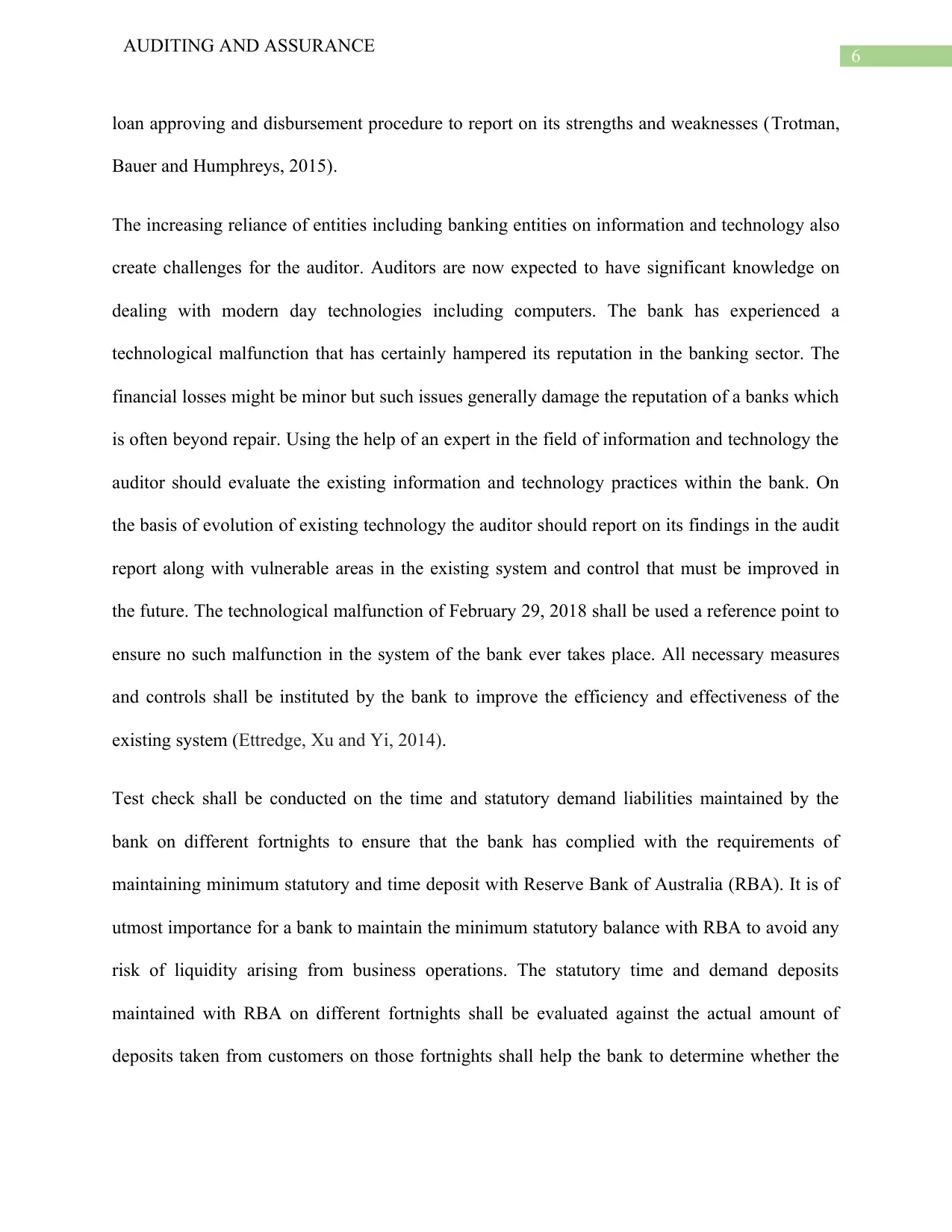
6
AUDITING AND ASSURANCE
loan approving and disbursement procedure to report on its strengths and weaknesses (Trotman,
Bauer and Humphreys, 2015).
The increasing reliance of entities including banking entities on information and technology also
create challenges for the auditor. Auditors are now expected to have significant knowledge on
dealing with modern day technologies including computers. The bank has experienced a
technological malfunction that has certainly hampered its reputation in the banking sector. The
financial losses might be minor but such issues generally damage the reputation of a banks which
is often beyond repair. Using the help of an expert in the field of information and technology the
auditor should evaluate the existing information and technology practices within the bank. On
the basis of evolution of existing technology the auditor should report on its findings in the audit
report along with vulnerable areas in the existing system and control that must be improved in
the future. The technological malfunction of February 29, 2018 shall be used a reference point to
ensure no such malfunction in the system of the bank ever takes place. All necessary measures
and controls shall be instituted by the bank to improve the efficiency and effectiveness of the
existing system (Ettredge, Xu and Yi, 2014).
Test check shall be conducted on the time and statutory demand liabilities maintained by the
bank on different fortnights to ensure that the bank has complied with the requirements of
maintaining minimum statutory and time deposit with Reserve Bank of Australia (RBA). It is of
utmost importance for a bank to maintain the minimum statutory balance with RBA to avoid any
risk of liquidity arising from business operations. The statutory time and demand deposits
maintained with RBA on different fortnights shall be evaluated against the actual amount of
deposits taken from customers on those fortnights shall help the bank to determine whether the
AUDITING AND ASSURANCE
loan approving and disbursement procedure to report on its strengths and weaknesses (Trotman,
Bauer and Humphreys, 2015).
The increasing reliance of entities including banking entities on information and technology also
create challenges for the auditor. Auditors are now expected to have significant knowledge on
dealing with modern day technologies including computers. The bank has experienced a
technological malfunction that has certainly hampered its reputation in the banking sector. The
financial losses might be minor but such issues generally damage the reputation of a banks which
is often beyond repair. Using the help of an expert in the field of information and technology the
auditor should evaluate the existing information and technology practices within the bank. On
the basis of evolution of existing technology the auditor should report on its findings in the audit
report along with vulnerable areas in the existing system and control that must be improved in
the future. The technological malfunction of February 29, 2018 shall be used a reference point to
ensure no such malfunction in the system of the bank ever takes place. All necessary measures
and controls shall be instituted by the bank to improve the efficiency and effectiveness of the
existing system (Ettredge, Xu and Yi, 2014).
Test check shall be conducted on the time and statutory demand liabilities maintained by the
bank on different fortnights to ensure that the bank has complied with the requirements of
maintaining minimum statutory and time deposit with Reserve Bank of Australia (RBA). It is of
utmost importance for a bank to maintain the minimum statutory balance with RBA to avoid any
risk of liquidity arising from business operations. The statutory time and demand deposits
maintained with RBA on different fortnights shall be evaluated against the actual amount of
deposits taken from customers on those fortnights shall help the bank to determine whether the
Paraphrase This Document
Need a fresh take? Get an instant paraphrase of this document with our AI Paraphraser
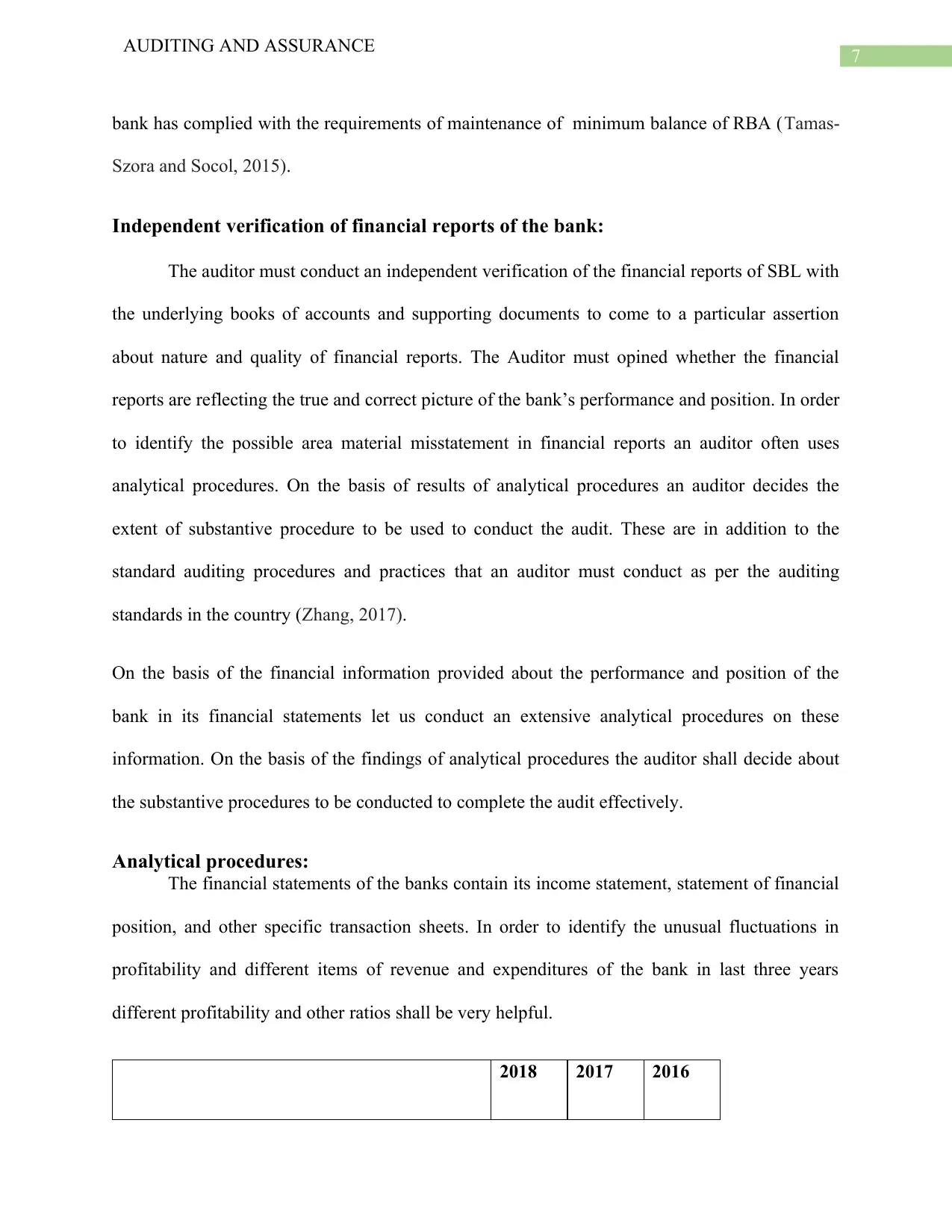
7
AUDITING AND ASSURANCE
bank has complied with the requirements of maintenance of minimum balance of RBA (Tamas-
Szora and Socol, 2015).
Independent verification of financial reports of the bank:
The auditor must conduct an independent verification of the financial reports of SBL with
the underlying books of accounts and supporting documents to come to a particular assertion
about nature and quality of financial reports. The Auditor must opined whether the financial
reports are reflecting the true and correct picture of the bank’s performance and position. In order
to identify the possible area material misstatement in financial reports an auditor often uses
analytical procedures. On the basis of results of analytical procedures an auditor decides the
extent of substantive procedure to be used to conduct the audit. These are in addition to the
standard auditing procedures and practices that an auditor must conduct as per the auditing
standards in the country (Zhang, 2017).
On the basis of the financial information provided about the performance and position of the
bank in its financial statements let us conduct an extensive analytical procedures on these
information. On the basis of the findings of analytical procedures the auditor shall decide about
the substantive procedures to be conducted to complete the audit effectively.
Analytical procedures:
The financial statements of the banks contain its income statement, statement of financial
position, and other specific transaction sheets. In order to identify the unusual fluctuations in
profitability and different items of revenue and expenditures of the bank in last three years
different profitability and other ratios shall be very helpful.
2018 2017 2016
AUDITING AND ASSURANCE
bank has complied with the requirements of maintenance of minimum balance of RBA (Tamas-
Szora and Socol, 2015).
Independent verification of financial reports of the bank:
The auditor must conduct an independent verification of the financial reports of SBL with
the underlying books of accounts and supporting documents to come to a particular assertion
about nature and quality of financial reports. The Auditor must opined whether the financial
reports are reflecting the true and correct picture of the bank’s performance and position. In order
to identify the possible area material misstatement in financial reports an auditor often uses
analytical procedures. On the basis of results of analytical procedures an auditor decides the
extent of substantive procedure to be used to conduct the audit. These are in addition to the
standard auditing procedures and practices that an auditor must conduct as per the auditing
standards in the country (Zhang, 2017).
On the basis of the financial information provided about the performance and position of the
bank in its financial statements let us conduct an extensive analytical procedures on these
information. On the basis of the findings of analytical procedures the auditor shall decide about
the substantive procedures to be conducted to complete the audit effectively.
Analytical procedures:
The financial statements of the banks contain its income statement, statement of financial
position, and other specific transaction sheets. In order to identify the unusual fluctuations in
profitability and different items of revenue and expenditures of the bank in last three years
different profitability and other ratios shall be very helpful.
2018 2017 2016
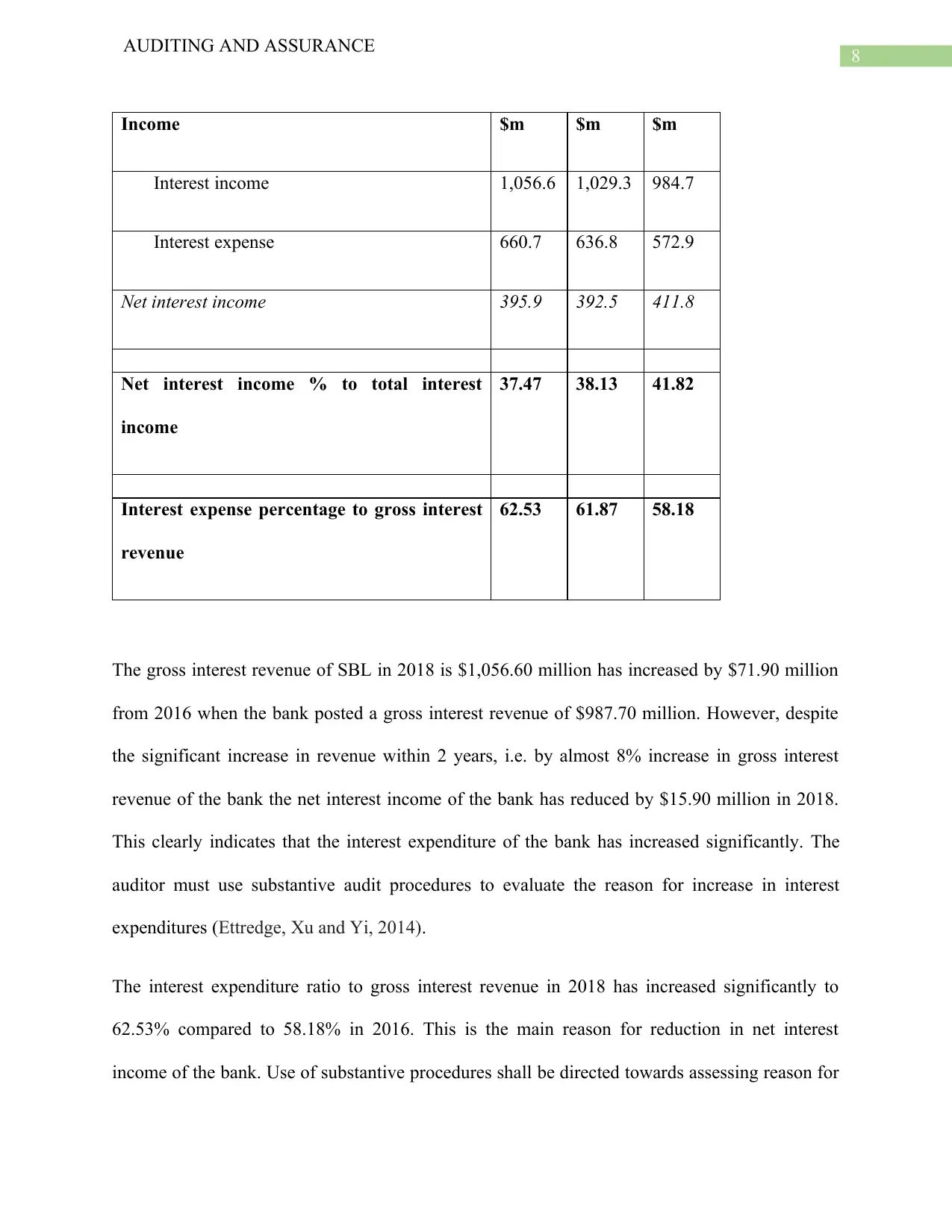
8
AUDITING AND ASSURANCE
Income $m $m $m
Interest income 1,056.6 1,029.3 984.7
Interest expense 660.7 636.8 572.9
Net interest income 395.9 392.5 411.8
Net interest income % to total interest
income
37.47 38.13 41.82
Interest expense percentage to gross interest
revenue
62.53 61.87 58.18
The gross interest revenue of SBL in 2018 is $1,056.60 million has increased by $71.90 million
from 2016 when the bank posted a gross interest revenue of $987.70 million. However, despite
the significant increase in revenue within 2 years, i.e. by almost 8% increase in gross interest
revenue of the bank the net interest income of the bank has reduced by $15.90 million in 2018.
This clearly indicates that the interest expenditure of the bank has increased significantly. The
auditor must use substantive audit procedures to evaluate the reason for increase in interest
expenditures (Ettredge, Xu and Yi, 2014).
The interest expenditure ratio to gross interest revenue in 2018 has increased significantly to
62.53% compared to 58.18% in 2016. This is the main reason for reduction in net interest
income of the bank. Use of substantive procedures shall be directed towards assessing reason for
AUDITING AND ASSURANCE
Income $m $m $m
Interest income 1,056.6 1,029.3 984.7
Interest expense 660.7 636.8 572.9
Net interest income 395.9 392.5 411.8
Net interest income % to total interest
income
37.47 38.13 41.82
Interest expense percentage to gross interest
revenue
62.53 61.87 58.18
The gross interest revenue of SBL in 2018 is $1,056.60 million has increased by $71.90 million
from 2016 when the bank posted a gross interest revenue of $987.70 million. However, despite
the significant increase in revenue within 2 years, i.e. by almost 8% increase in gross interest
revenue of the bank the net interest income of the bank has reduced by $15.90 million in 2018.
This clearly indicates that the interest expenditure of the bank has increased significantly. The
auditor must use substantive audit procedures to evaluate the reason for increase in interest
expenditures (Ettredge, Xu and Yi, 2014).
The interest expenditure ratio to gross interest revenue in 2018 has increased significantly to
62.53% compared to 58.18% in 2016. This is the main reason for reduction in net interest
income of the bank. Use of substantive procedures shall be directed towards assessing reason for
⊘ This is a preview!⊘
Do you want full access?
Subscribe today to unlock all pages.

Trusted by 1+ million students worldwide
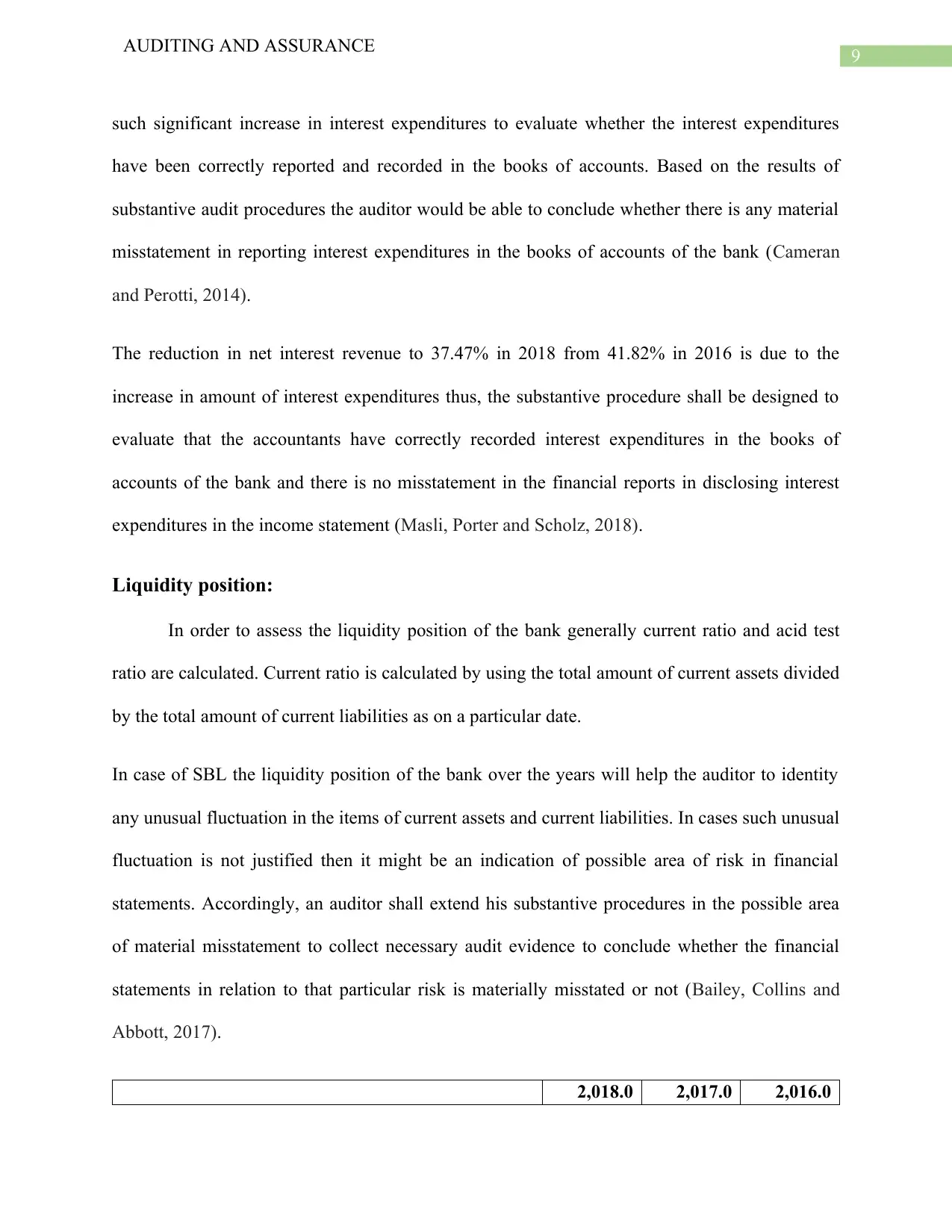
9
AUDITING AND ASSURANCE
such significant increase in interest expenditures to evaluate whether the interest expenditures
have been correctly reported and recorded in the books of accounts. Based on the results of
substantive audit procedures the auditor would be able to conclude whether there is any material
misstatement in reporting interest expenditures in the books of accounts of the bank (Cameran
and Perotti, 2014).
The reduction in net interest revenue to 37.47% in 2018 from 41.82% in 2016 is due to the
increase in amount of interest expenditures thus, the substantive procedure shall be designed to
evaluate that the accountants have correctly recorded interest expenditures in the books of
accounts of the bank and there is no misstatement in the financial reports in disclosing interest
expenditures in the income statement (Masli, Porter and Scholz, 2018).
Liquidity position:
In order to assess the liquidity position of the bank generally current ratio and acid test
ratio are calculated. Current ratio is calculated by using the total amount of current assets divided
by the total amount of current liabilities as on a particular date.
In case of SBL the liquidity position of the bank over the years will help the auditor to identity
any unusual fluctuation in the items of current assets and current liabilities. In cases such unusual
fluctuation is not justified then it might be an indication of possible area of risk in financial
statements. Accordingly, an auditor shall extend his substantive procedures in the possible area
of material misstatement to collect necessary audit evidence to conclude whether the financial
statements in relation to that particular risk is materially misstated or not (Bailey, Collins and
Abbott, 2017).
2,018.0 2,017.0 2,016.0
AUDITING AND ASSURANCE
such significant increase in interest expenditures to evaluate whether the interest expenditures
have been correctly reported and recorded in the books of accounts. Based on the results of
substantive audit procedures the auditor would be able to conclude whether there is any material
misstatement in reporting interest expenditures in the books of accounts of the bank (Cameran
and Perotti, 2014).
The reduction in net interest revenue to 37.47% in 2018 from 41.82% in 2016 is due to the
increase in amount of interest expenditures thus, the substantive procedure shall be designed to
evaluate that the accountants have correctly recorded interest expenditures in the books of
accounts of the bank and there is no misstatement in the financial reports in disclosing interest
expenditures in the income statement (Masli, Porter and Scholz, 2018).
Liquidity position:
In order to assess the liquidity position of the bank generally current ratio and acid test
ratio are calculated. Current ratio is calculated by using the total amount of current assets divided
by the total amount of current liabilities as on a particular date.
In case of SBL the liquidity position of the bank over the years will help the auditor to identity
any unusual fluctuation in the items of current assets and current liabilities. In cases such unusual
fluctuation is not justified then it might be an indication of possible area of risk in financial
statements. Accordingly, an auditor shall extend his substantive procedures in the possible area
of material misstatement to collect necessary audit evidence to conclude whether the financial
statements in relation to that particular risk is materially misstated or not (Bailey, Collins and
Abbott, 2017).
2,018.0 2,017.0 2,016.0
Paraphrase This Document
Need a fresh take? Get an instant paraphrase of this document with our AI Paraphraser
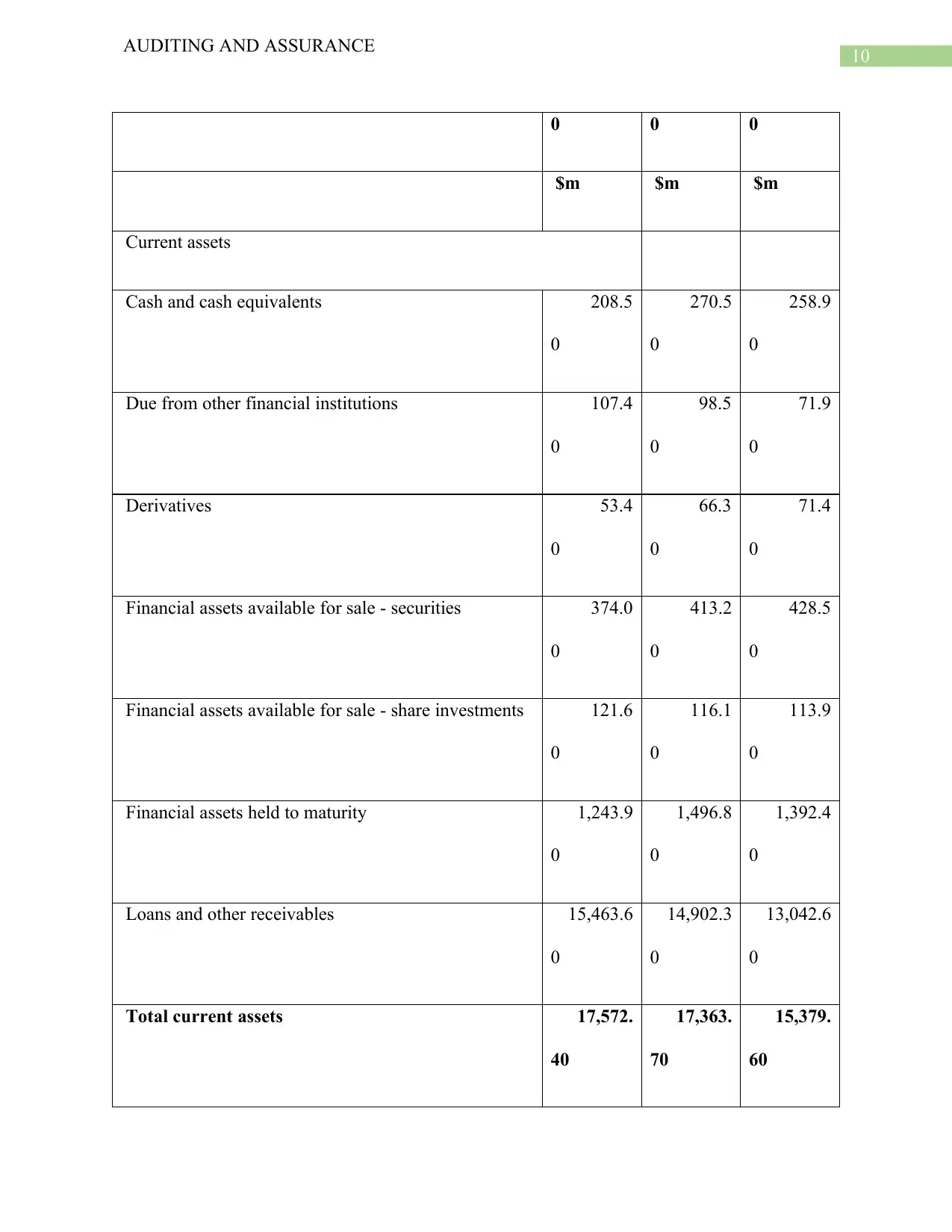
10
AUDITING AND ASSURANCE
0 0 0
$m $m $m
Current assets
Cash and cash equivalents 208.5
0
270.5
0
258.9
0
Due from other financial institutions 107.4
0
98.5
0
71.9
0
Derivatives 53.4
0
66.3
0
71.4
0
Financial assets available for sale - securities 374.0
0
413.2
0
428.5
0
Financial assets available for sale - share investments 121.6
0
116.1
0
113.9
0
Financial assets held to maturity 1,243.9
0
1,496.8
0
1,392.4
0
Loans and other receivables 15,463.6
0
14,902.3
0
13,042.6
0
Total current assets 17,572.
40
17,363.
70
15,379.
60
AUDITING AND ASSURANCE
0 0 0
$m $m $m
Current assets
Cash and cash equivalents 208.5
0
270.5
0
258.9
0
Due from other financial institutions 107.4
0
98.5
0
71.9
0
Derivatives 53.4
0
66.3
0
71.4
0
Financial assets available for sale - securities 374.0
0
413.2
0
428.5
0
Financial assets available for sale - share investments 121.6
0
116.1
0
113.9
0
Financial assets held to maturity 1,243.9
0
1,496.8
0
1,392.4
0
Loans and other receivables 15,463.6
0
14,902.3
0
13,042.6
0
Total current assets 17,572.
40
17,363.
70
15,379.
60
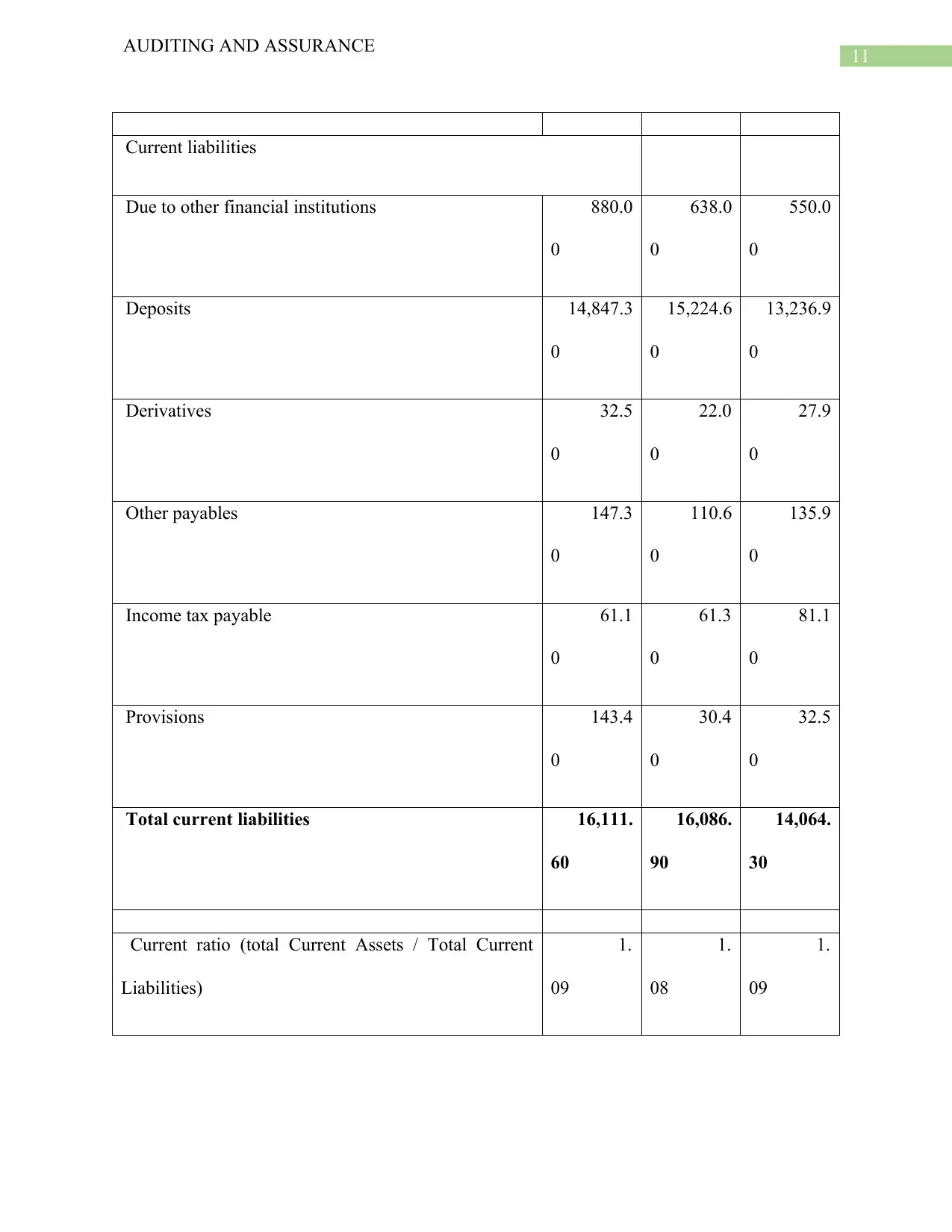
11
AUDITING AND ASSURANCE
Current liabilities
Due to other financial institutions 880.0
0
638.0
0
550.0
0
Deposits 14,847.3
0
15,224.6
0
13,236.9
0
Derivatives 32.5
0
22.0
0
27.9
0
Other payables 147.3
0
110.6
0
135.9
0
Income tax payable 61.1
0
61.3
0
81.1
0
Provisions 143.4
0
30.4
0
32.5
0
Total current liabilities 16,111.
60
16,086.
90
14,064.
30
Current ratio (total Current Assets / Total Current
Liabilities)
1.
09
1.
08
1.
09
AUDITING AND ASSURANCE
Current liabilities
Due to other financial institutions 880.0
0
638.0
0
550.0
0
Deposits 14,847.3
0
15,224.6
0
13,236.9
0
Derivatives 32.5
0
22.0
0
27.9
0
Other payables 147.3
0
110.6
0
135.9
0
Income tax payable 61.1
0
61.3
0
81.1
0
Provisions 143.4
0
30.4
0
32.5
0
Total current liabilities 16,111.
60
16,086.
90
14,064.
30
Current ratio (total Current Assets / Total Current
Liabilities)
1.
09
1.
08
1.
09
⊘ This is a preview!⊘
Do you want full access?
Subscribe today to unlock all pages.

Trusted by 1+ million students worldwide
1 out of 22
Related Documents
Your All-in-One AI-Powered Toolkit for Academic Success.
+13062052269
info@desklib.com
Available 24*7 on WhatsApp / Email
![[object Object]](/_next/static/media/star-bottom.7253800d.svg)
Unlock your academic potential
Copyright © 2020–2025 A2Z Services. All Rights Reserved. Developed and managed by ZUCOL.



